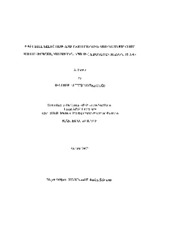| dc.creator | Mathewson, Heather Alexis | |
| dc.date.accessioned | 2012-06-07T23:16:12Z | |
| dc.date.available | 2012-06-07T23:16:12Z | |
| dc.date.created | 2002 | |
| dc.date.issued | 2002 | |
| dc.identifier.uri | https://hdl.handle.net/1969.1/ETD-TAMU-2002-THESIS-M378 | |
| dc.description | Due to the character of the original source materials and the nature of batch digitization, quality control issues may be present in this document. Please report any quality issues you encounter to digital@library.tamu.edu, referencing the URI of the item. | en |
| dc.description | Includes bibliographical references (leaves 52-66). | en |
| dc.description | Issued also on microfiche from Lange Micrographics. | en |
| dc.description.abstract | Local natural communities can be negatively impacted by native species' range expansion into previously uninhabited areas. Recently, white-winged doves (Zenaida asiatica) have expanded their geographical range into areas where mourning (Z. macroura) and Inca (Columbina inca) doves have traditionally nested. The first record of breeding white-winged doves in Mason, Texas was in 1992. Mourning doves once nested throughout Mason but local residents have observed a sharp decline over the last decade. Several studies have focused on descriptions of individual species' nesting habits yet few studies exist that compare sympatric populations of these dove species. With the invasion of white-winged doves into new geographic locations, the potential for competition exists between them and smaller Columbids. The objectives of my study were to: (1) determine spatial distribution of the 3 dove species in Mason, Texas; (2) examine the effect of nesting aggregations of white-winged doves on the other 2 species; and (3) compare nest-site characteristics, nest-site partitioning, and assess the role of interspecific competition on nest-site selection. Nest searching, monitoring, nest-site characterizations, and vegetation measurements were conducted during June-August 2001. White-winged doves (n = 89) appeared to select residential and urban centers over the rural periphery of the town (97%), while 81% of the mourning dove nests (n = 27) were located on the outskirts of town. Inca doves (n = 20) appeared to nest equally in both locations. Of the 3 dove species, mourning dove nest success (37%, n = 27) was low, white-winged dove nest success was 50% (n = 78) and Inca dove nest success (62%, n = 21) was high. White-winged doves often nested near another white-winged dove nest, yet nest success increased with distance from another active nest. Nest-site characteristics indicated differential resource use, therefore, it is suggested the 3 dove species were partitioning nest sites. While it appears white-winged doves may be excluding mourning doves from residential and urban areas, future research is needed to determine whether this is detrimental to the mourning dove population. | en |
| dc.format.medium | electronic | en |
| dc.format.mimetype | application/pdf | |
| dc.language.iso | en_US | |
| dc.publisher | Texas A&M University | |
| dc.rights | This thesis was part of a retrospective digitization project authorized by the Texas A&M University Libraries in 2008. Copyright remains vested with the author(s). It is the user's responsibility to secure permission from the copyright holder(s) for re-use of the work beyond the provision of Fair Use. | en |
| dc.subject | wildlife and fisheries sciences. | en |
| dc.subject | Major wildlife and fisheries sciences. | en |
| dc.title | Nest site selection and partitioning among sympatric white-winged, mourning, and Inca doves in Mason, Texas | en |
| dc.type | Thesis | en |
| thesis.degree.discipline | wildlife and fisheries sciences | en |
| thesis.degree.name | M.S. | en |
| thesis.degree.level | Masters | en |
| dc.type.genre | thesis | en |
| dc.type.material | text | en |
| dc.format.digitalOrigin | reformatted digital | en |


